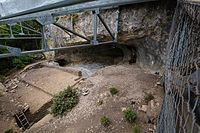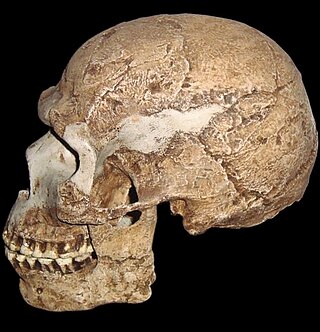
Early modern human (EMH), or anatomically modern human (AMH), are terms used to distinguish Homo sapiens that are anatomically consistent with the range of phenotypes seen in contemporary humans, from extinct archaic human species. This distinction is useful especially for times and regions where anatomically modern and archaic humans co-existed, for example, in Paleolithic Europe. Among the oldest known remains of Homo sapiens are those found at the Omo-Kibish I archaeological site in south-western Ethiopia, dating to about 233,000 to 196,000 years ago, the Florisbad site in South Africa, dating to about 259,000 years ago, and the Jebel Irhoud site in Morocco, dated about 315,000 years ago.

Behavioral modernity is a suite of behavioral and cognitive traits believed to distinguish current Homo sapiens from other anatomically modern humans, hominins, and primates. Most scholars agree that modern human behavior can be characterized by abstract thinking, planning depth, symbolic behavior, music and dance, exploitation of large game, and blade technology, among others. Underlying these behaviors and technological innovations are cognitive and cultural foundations that have been documented experimentally and ethnographically by evolutionary and cultural anthropologists. These human universal patterns include cumulative cultural adaptation, social norms, language, and extensive help and cooperation beyond close kin.

The Upper Paleolithic is the third and last subdivision of the Paleolithic or Old Stone Age. Very broadly, it dates to between 50,000 and 12,000 years ago, according to some theories coinciding with the appearance of behavioral modernity in early modern humans, until the advent of the Neolithic Revolution and agriculture.
The Middle Paleolithic is the second subdivision of the Paleolithic or Old Stone Age as it is understood in Europe, Africa and Asia. The term Middle Stone Age is used as an equivalent or a synonym for the Middle Paleolithic in African archeology. The Middle Paleolithic broadly spanned from 300,000 to 50,000 years ago. There are considerable dating differences between regions. The Middle Paleolithic was succeeded by the Upper Paleolithic subdivision which first began between 50,000 and 40,000 years ago. Pettit and White date the Early Middle Paleolithic in Great Britain to about 325,000 to 180,000 years ago, and the Late Middle Paleolithic as about 60,000 to 35,000 years ago. The Middle Paleolithic was in the geological Chibanian and Late Pleistocene ages.
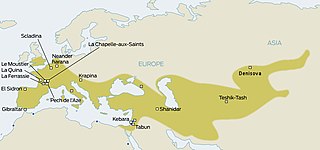
Neanderthals became extinct around 40,000 years ago. Hypotheses on the causes of the extinction include violence, transmission of diseases from modern humans which Neanderthals had no immunity to, competitive replacement, extinction by interbreeding with early modern human populations, natural catastrophes, climate change and inbreeding depression. It is likely that multiple factors caused the demise of an already low population.

Prehistoric France is the period in the human occupation of the geographical area covered by present-day France which extended through prehistory and ended in the Iron Age with the Roman conquest, when the territory enters the domain of written history.
The Neanderthal genome project is an effort of a group of scientists to sequence the Neanderthal genome, founded in July 2006.

Gorham's Cave is a sea-level cave in the British overseas territory of Gibraltar. Though not a sea cave, it is often mistaken for one. Considered to be one of the last known habitations of the Neanderthals in Europe, the cave gives its name to the Gorham's Cave complex, which is a combination of four distinct caves of such importance that they are combined into a UNESCO World Heritage Site, the only one in Gibraltar. The three other caves are Vanguard Cave, Hyaena Cave, and Bennett's Cave.
Paleolithic Europe, or Old Stone Age Europe, encompasses the Paleolithic or Old Stone Age in Europe from the arrival of the first archaic humans, about 1.4 million years ago until the beginning of the Mesolithic around 10,000 years ago. This period thus covers over 99% of the total human presence on the European continent. The early arrival and disappearance of Homo erectus and Homo heidelbergensis, the appearance, complete evolution and eventual demise of Homo neanderthalensis and the immigration and successful settlement of Homo sapiens all have taken place during the European Paleolithic.
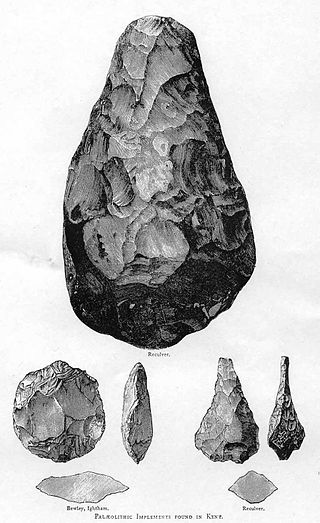
The oldest undisputed examples of figurative art are known from Europe and from Sulawesi, Indonesia, dated about 35,000 years old . Together with religion and other cultural universals of contemporary human societies, the emergence of figurative art is a necessary attribute of full behavioral modernity.

Cro-Magnons or European early modern humans (EEMH) were the first early modern humans to settle in Europe, migrating from western Asia, continuously occupying the continent possibly from as early as 56,800 years ago. They interacted and interbred with the indigenous Neanderthals of Europe and Western Asia, who went extinct 40,000 to 35,000 years ago. The first wave of modern humans in Europe left no genetic legacy to modern Europeans; however, from 37,000 years ago a second wave succeeded in forming a single founder population, from which all subsequent Cro-Magnons descended and which contributes ancestry to present-day Europeans. Cro-Magnons produced Upper Palaeolithic cultures, the first major one being the Aurignacian, which was succeeded by the Gravettian by 30,000 years ago. The Gravettian split into the Epi-Gravettian in the east and Solutrean in the west, due to major climatic degradation during the Last Glacial Maximum (LGM), peaking 21,000 years ago. As Europe warmed, the Solutrean evolved into the Magdalenian by 20,000 years ago, and these peoples recolonised Europe. The Magdalenian and Epi-Gravettian gave way to Mesolithic cultures as big game animals were dying out and the Last Glacial Period drew to a close.

The Denisovans or Denisova hominins(di-NEE-sə-və) are an extinct species or subspecies of archaic human that ranged across Asia during the Lower and Middle Paleolithic, and lived, based on current evidence, from 285 to 25 thousand years ago. Denisovans are known from few physical remains; consequently, most of what is known about them comes from DNA evidence. No formal species name has been established pending more complete fossil material.

Neanderthals are an extinct group of archaic humans who lived in Eurasia until about 40,000 years ago. The type specimen, Neanderthal 1, was found in 1856 in the Neander Valley in present-day Germany.

The Skhul and Qafzeh hominins or Qafzeh–Skhul early modern humans are hominin fossils discovered in Es-Skhul and Qafzeh caves in Israel. They are today classified as Homo sapiens, among the earliest of their species in Eurasia. Skhul Cave is on the slopes of Mount Carmel; Qafzeh Cave is a rockshelter near Nazareth in Lower Galilee.

Almost everything about Neanderthal behaviour remains controversial. From their physiology, Neanderthals are presumed to have been omnivores, but animal protein formed the majority of their dietary protein, showing them to have been carnivorous apex predators and not scavengers. Although very little is known of their social organization, it appears patrilines would make up the nucleus of the tribe, and women would seek out partners in neighbouring tribes once reaching adolescence, presumably to avoid inbreeding. An analysis based on finger-length ratios suggests that Neanderthals were more sexually competitive and promiscuous than modern-day humans.

Interbreeding between archaic and modern humans occurred during the Middle Paleolithic and early Upper Paleolithic. The interbreeding happened in several independent events that included Neanderthals and Denisovans, as well as several unidentified hominins.
Mezmaiskaya Cave is a prehistoric cave site overlooking the right bank of the Sukhoi Kurdzhips in the southern Russian Republic of Adygea, located in the northwestern foothills of the North Caucasus in the Caucasus Mountains system.
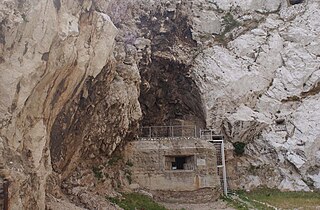
Forbes' Quarry is located on the northern face of the Rock of Gibraltar within the Upper Rock Nature Reserve in the British Overseas Territory of Gibraltar. The area was quarried during the 19th century to supply stone for reinforcing the fortress' military installations. In the course of the quarrying, a limestone cave was found. The second ever Neanderthal discovery was made within this cave when Cpt. Edmund Flint found the skull of an adult female Neanderthal in 1848.

Scladina, or Sclayn Cave, is an archaeological site located in Wallonia in the town of Sclayn, in the Andenne hills in Belgium, where excavations since 1978 have provided the material for an exhaustive collection of over thirteen thousand Mousterian stone artifacts and the fossilized remains of an especially ancient Neanderthal, called the Scladina child were discovered in 1993.
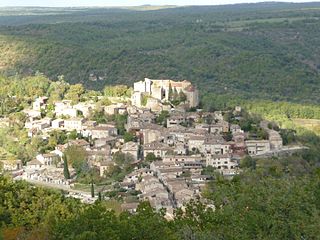
Bruniquel Cave is an archeological site near Bruniquel, in an area which has many paleolithic sites, east of Montauban in southwestern France. Annular (ring) and accumulation (pile) structures made of broken stalagmites have been found 336 metres from the cave entrance. Traces of fire were also found. The constructions have been dated to approximately 176,000 years ago.

